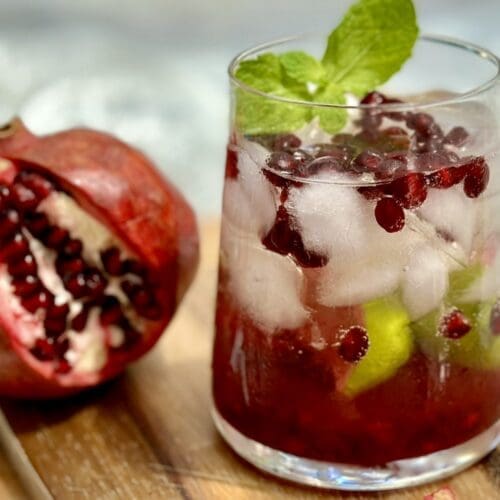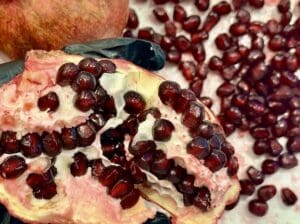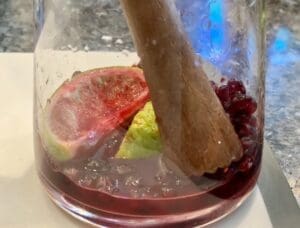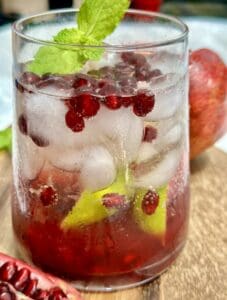
Pomegranate Cocktails with Champagne
Raise your glass with these gorgeous Pomegranate Cocktails. An enticing mix of Champagne, vodka, lime wedges, pomegranate liqueur and arils.
Video
Ingredients
- 40gm / 1.4oz pomegranate arils (more for garnish) (NOTE 1)
- 1 tsp caster sugar (or regular white sugar) (NOTE 2)
- 2 lime wedges
- 15ml / 0.5floz pomegranate liqueur (NOTE 3)
- 15ml / 0.5floz vodka (NOTE 4)
- ice cubes
- 160ml / 5.5floz Champagne (or sparkling wine) (NOTE 5)
Garnish
- pomegranate arils
- mint leaves
Instructions
- To remove pomegranate arils - Use a sharp knife to score the skin along the ridges from top to bottom without cutting in too deep. Using your hands, gently break it apart, separating the arils from the pith. Some people prefer to do this in a bowl of water, as it's less messy.

- In a lowball glass (old-fashioned or rocks glass), muddle the arils, sugar, and lime wedges together until the sugar dissolves. The juice should also be extracted from the lime wedges and arils. This can be done using a muddler or the back of a wooden spoon.

- Add the pomegranate liqueur, followed by the vodka. Next, add some ice, then pour in the Champagne or sparkling wine. Garnish with more pomegranate arils and a mint leaf. Before serving, give it a good stir and enjoy!

Notes
(NOTE 1) Pomegranate arils - Fresh pomegranate arils are better tasting, but frozen ones would work too.
(NOTE 2) Caster sugar (superfine sugar or baker's sugar) is a type of granulated white sugar that has a very fine texture. Many baking or dessert recipes call for caster sugar as it dissolves faster and better into mixtures. If you can't find caster sugar, you can make your own by placing regular white sugar in a food processor or blender. Pulse the sugar a few times until it looks finer, but don't over-blitz it to a powder consistency. Alternatively, you could just use equal amounts of regular white sugar.
(NOTE 3) Pomegranate liqueur has a sweet and tart taste, similar to fresh pomegranate juice with subtle flavours of berry and citrus. If you have no pomegranate liqueur on hand, you could swap for equal amounts of cherry or raspberry liqueur.
(NOTE 4) Vodka - I used Absolut, but you could use your favourite vodka brand such as Smirnoff and Grey Goose. If you're not a fan of vodka, you could swap it for equal amounts of gin.
(NOTE 5) Champagne - If you want to indulge, go for Champagne, but I couldn't bring myself to, so I settled for sparkling wine. You could also use Prosecco, an Italian sparkling wine.
I've used a third-party application to calculate the calories and nutritional information, so please use this as an approximate guide only.
Cooking measurements are in Australian standard spoon and cup measurements. For specific details and conversions, visit our Australian Cooking Measurements page.
Nutrition
Serving: 1 ServingCalories: 210kcalCarbohydrates: 19gProtein: 1gFat: 1gSaturated Fat: 0.1gPolyunsaturated Fat: 0.1gMonounsaturated Fat: 0.04gSodium: 14mgPotassium: 245mgFiber: 2gSugar: 16gVitamin A: 1IUVitamin C: 5mgCalcium: 19mgIron: 1mg